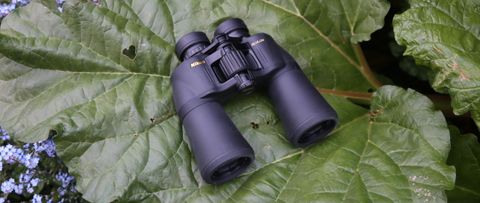Space Verdict
The Nikon 10x50 Aculon A211 is ideal for anyone just starting out in stargazing. They're a bit bulky for travel and they don't offer much eye relief, but they're bright and sharp enough for impressive entry-level astronomy.
Pros
- +
Great value for money binoculars
- +
Offer a wide field of view
- +
Sleek design
- +
Good optical quality
Cons
- -
Lack of eye relief
- -
Closest focus is 23 feet/7 meters
- -
Some chromatic aberration
- -
Some blur at the edges of the image
Why you can trust Space.com
It's one thing to decide you want binoculars instead of one of the best telescopes, but quite another to opt for an entry-level pair like the Nikon 10x50 Aculon A211 that just seems impossibly affordable. Can they really be any good? With 10x magnification and 50 mm objective lenses, the Nikon 10x50 Aculon A211 are ideally sized for astronomy, but also the perfect step-up size for everything from birdwatching and safari to hiking and sports stadiums.
Magnification: 10x
Objective lens diameter: 50mm
Angular field of view: 6.5 degrees
Eye relief: 0.46-inch/11.8mm
Weight: 31.7oz/899g
However, at this low price, you shouldn't expect the very latest materials and optics to be used. In fact, the Nikon 10x50 Aculon A211 cuts a lot of corners and is surprisingly lightweight. So why are the Nikon 10x50 Aculon A211 among the best binoculars available? Here's why we think they are ideal for anyone starting out in stargazing.
Nikon 10x50 Aculon A211 binoculars: design
- Porro prisms
- BaK-4 glass optics
- Textured thumb pads
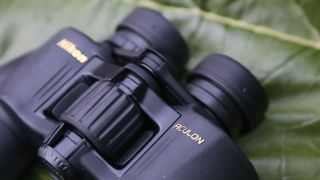
The Nikon 10x50 Aculon A211 are porro prism binoculars. That means they use optical tubes that are much farther apart than on the more compact roof prism designs. It means the Nikon 10x50 Aculon A211 takes up more space than some rivals, but there are advantages. The main plus point is brightness. Devoid of high-end optics and proprietary lens coatings (though there are unmissable greenish anti-reflective coatings on the objective lenses to improve color fidelity), the Nikon 10x50 Aculon A211's porro prism design maximizes the brightness of the image. That advantage is underscored by the use of high-density BAK-4 glass prisms, which is of better optical quality than BK-7, which you'll often find on other binoculars in the same price category.
Objective lens caps
Rainguard for eyecups
Shoulder strap
Padded carry case
Although we could find no particular problems in terms of build quality, there are a few giveaways these binoculars are more affordable. For example, we really enjoyed using the focusing wheel on the optical bridge between the tubes. It's smooth and resistant, making it easy to toggle between different focuses. However, as you move it you can hear the lubricant inside. That's not a dealbreaker, but it's not something you're going to notice on more expensive binoculars. Much more importantly though, that ocular bridge is stable and not the physical weak point it so often is on entry-level binoculars.
We also liked the ridge and the textured pads on the rubber armor situated beneath the optical engine. However, although it makes the Nikon 10x50 Aculon A211 easier to hold, these pads do have tiny air pockets underneath them, making the rubber armor seem a little loose.
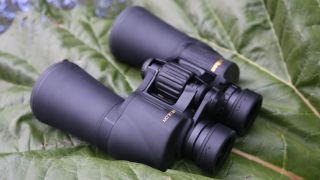
Nikon 10x50 Aculon A211 binoculars: Performance
- Bright and sharp images
- Some chromatic aberration
- 23 feet/7 meter close focus
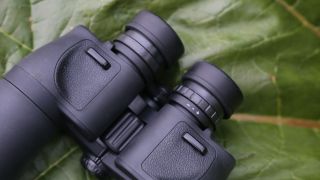
Porro prism binoculars like the Nikon 10x50 Aculon A211 are all about brightness, which helps make the 50mm objective lenses allow in a lot of light at night. Reasonably lightweight to hold at just 31.7oz/899g, the Nikon 10x50 Aculon A211's wide 6.5 degrees field of view proved ideally suited to sweeping across star fields. We were lucky enough to take the Nikon 10x50 Aculon A211 to a dark sky site in late spring, from where we were able to study the star fields and nebula around the constellations of Scorpius and Sagittarius.
The results were sharp stars in the center of the field, but with a distinct blur on the outer edge. That's to be expected at this price point so we weren't too disappointed. Ditto a purplish line around a First Quarter Moon, which is something else only step-up binoculars begin to address. Crucially, neither issue is major and certainly won't bother anyone just starting out in their stargazing career.
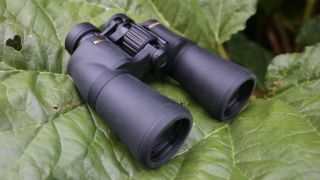
Something to bear in mind about the Nikon 10x50 Aculon A211 is there are limited abilities with the minimum focusing distance. While you can use the Nikon 10x50 Aculon A211 at home in your backyard, the closest you can get to plants, birds and other objects is 23 feet/7 meters. So if you plan to do a lot of bird watching at home, it might be wise to avoid these binoculars and invest in some with a closer focus.
If you're planning on taking a pair of binoculars on a trip with the intention of studying the night sky, do bear in mind that porro prism binoculars like the Nikon 10x50 Aculon A211 are substantially wider than roof prism binoculars and can't be folded into a shape that is as space-efficient.
Nikon 10x50 Aculon A211 binoculars: Functionality
- Grippy rubber armor
- Objective lens caps are easy to lose
- Lack eye relief
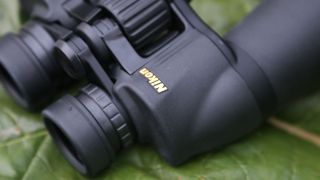
The Nikon 10x50 Aculon A211 are a step-down, cut-price version of Nikon's Action EX series of binoculars, but there's not much to tell them apart. The rubber armor that covered the optical engine and the tubes aren't as nice to touch as on the Action EX. It feels rather rubbery and resistant, but that's actually a positive in terms of adding extra grip.
We don't like the Nikon 10x50 Aculon A211's objective lens caps. They're just too easy to lose. Although they are fairly snug when popped onto the front of the objective lenses, we're just not a fan of going outside into the dark with small plastic items that are easily losable. Especially since many brands of binoculars now have objective lens caps that are permanently attached to the objective lenses, and simply hang down. We have less of a problem with the rain guard for the eyecups, which are a normal figure of eight configuration and they can be attached to a neck strap that's supplied in the box.
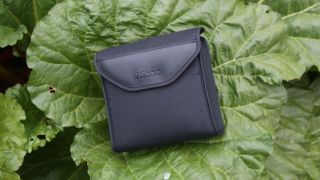
However, the biggest issue with the Nikon 10x50 Aculon A211 isn't the build quality or its images, but the eyecups' lack of eye relief. Eye relief refers to the distance you should have your eyes from the eyepiece. Ideally, a pair of binoculars should have at least 15mm of eye release, which will make them usable by anyone who wears spectacles. However, on these binoculars you get only 0.46-inch/11.8mm of eye relief, so we wouldn't recommend them to those who wear glasses. However, we did like the eyecups themselves, which turn up smoothly in two different positions.
Although it's unlikely that anyone will want to put the Nikon 10x50 Aculon A211 on a tripod, it is possible; a small 3/4-inch adaptor is revealed if you unscrew the coin-sized Nikon logo behind the focusing wheel.
Should you buy the Nikon 10x50 Aculon A211 binoculars?
The Nikon 10x50 Aculon A211 is capable of doing a seriously impressive job for some users. If you are starting out in your stargazing career and you just want to get a deeper look at the night sky from home — seeing further into constellations and star clusters — the Nikon 10x50 Aculon A211 will serve you well.
However, they're not the all-rounders they might appear to be. As well as not being ideal for astro-travel due to their bulky width, there is some noticeable blur around the edges of the field of view and an inability to focus on anything close to the observer. Still, at this low price, we were hugely impressed by the performance of the Nikon 10x50 Aculon A211 both at night and during the day.
If the Nikon 10x50 Aculon A211 binoculars aren't for you
A good alternative to the Nikon 10x50 Aculon A211, if you're after something more travel-friendly, would be the Opticron Adventurer II WP 10x50 roof prism binoculars. For an even more affordable option consider the Celestron UpClose G2 10x50, a good value pair of entry-level binoculars. At the other end of the scale would be the Canon 10x42L IS WP, which will give you a slightly wider field of view and some electronic image stabilization wizardry.
Join our Space Forums to keep talking space on the latest missions, night sky and more! And if you have a news tip, correction or comment, let us know at: community@space.com.

Jamie is an experienced science, technology and travel journalist and stargazer who writes about exploring the night sky, solar and lunar eclipses, moon-gazing, astro-travel, astronomy and space exploration. He is the editor of WhenIsTheNextEclipse.com and author of A Stargazing Program For Beginners, and is a senior contributor at Forbes. His special skill is turning tech-babble into plain English.
